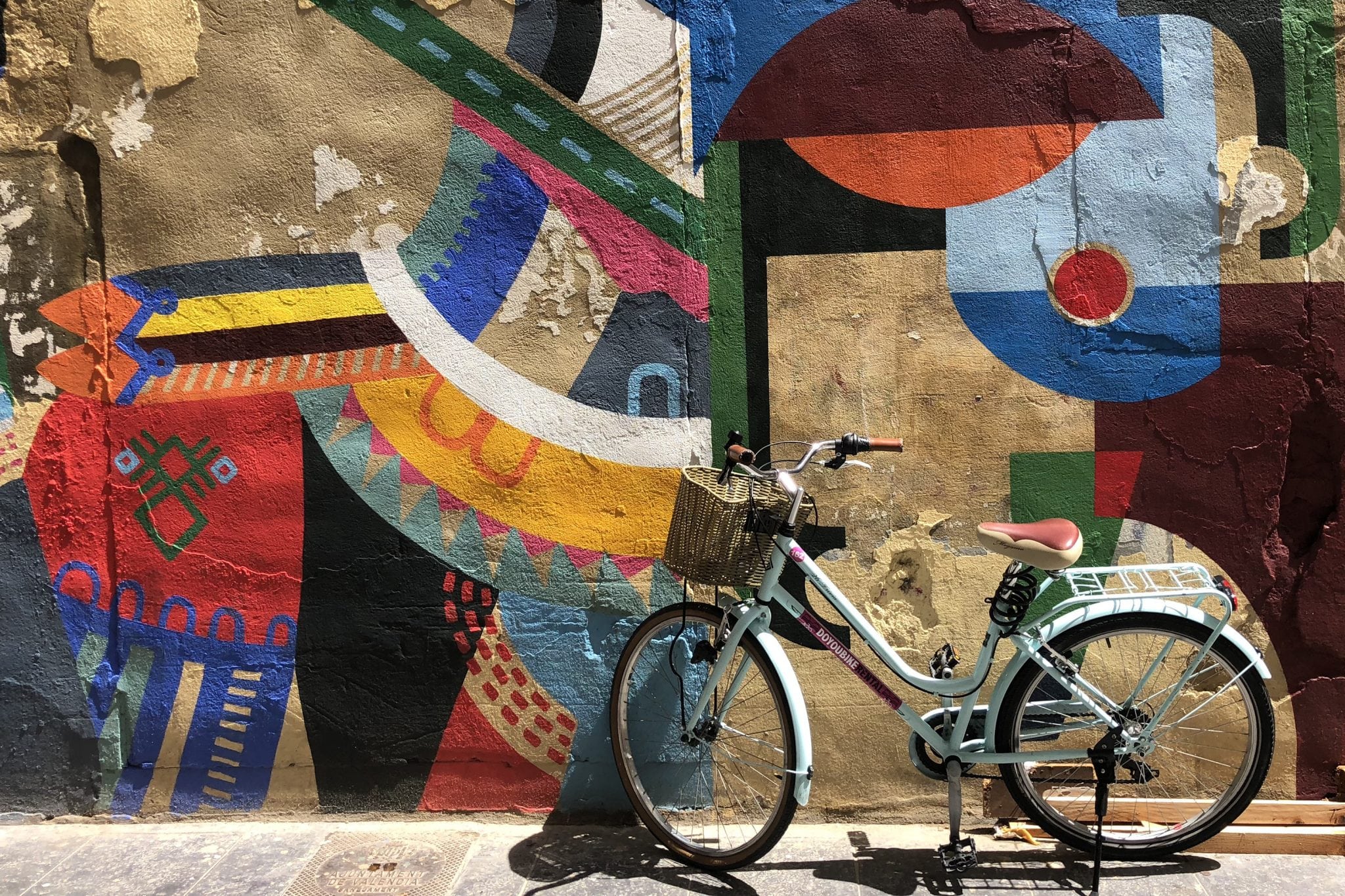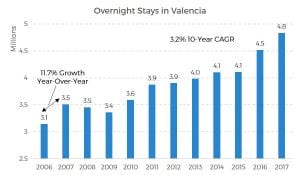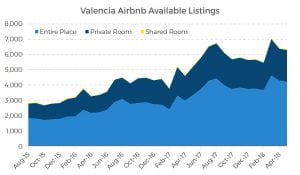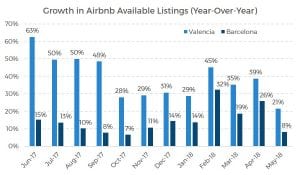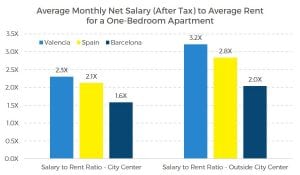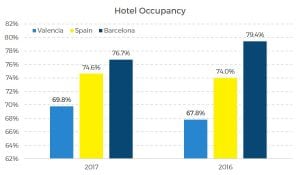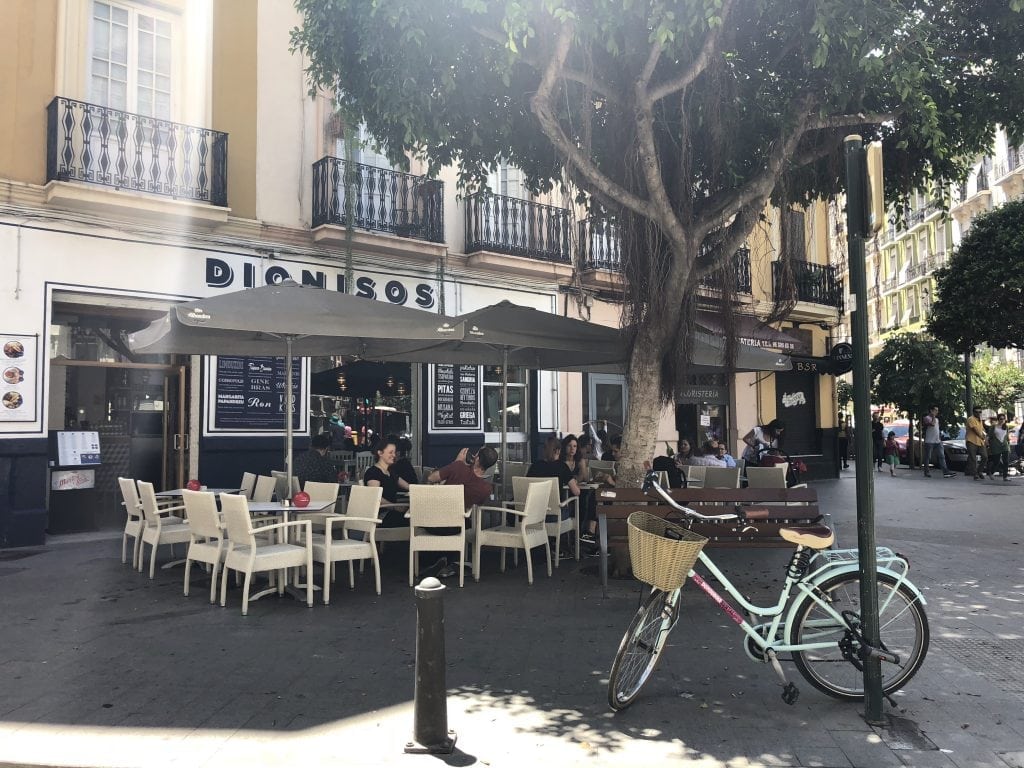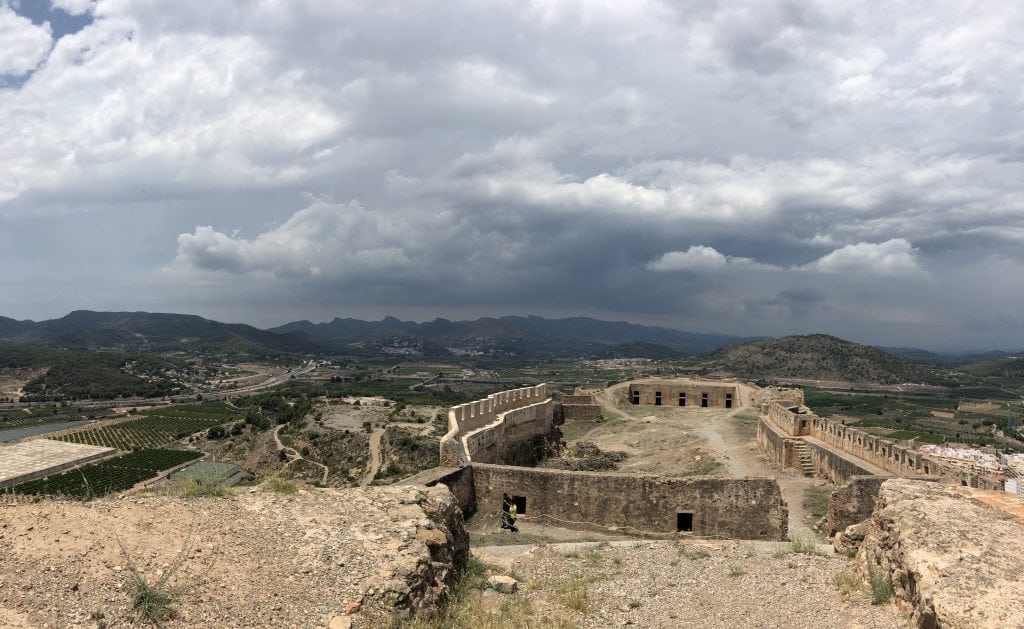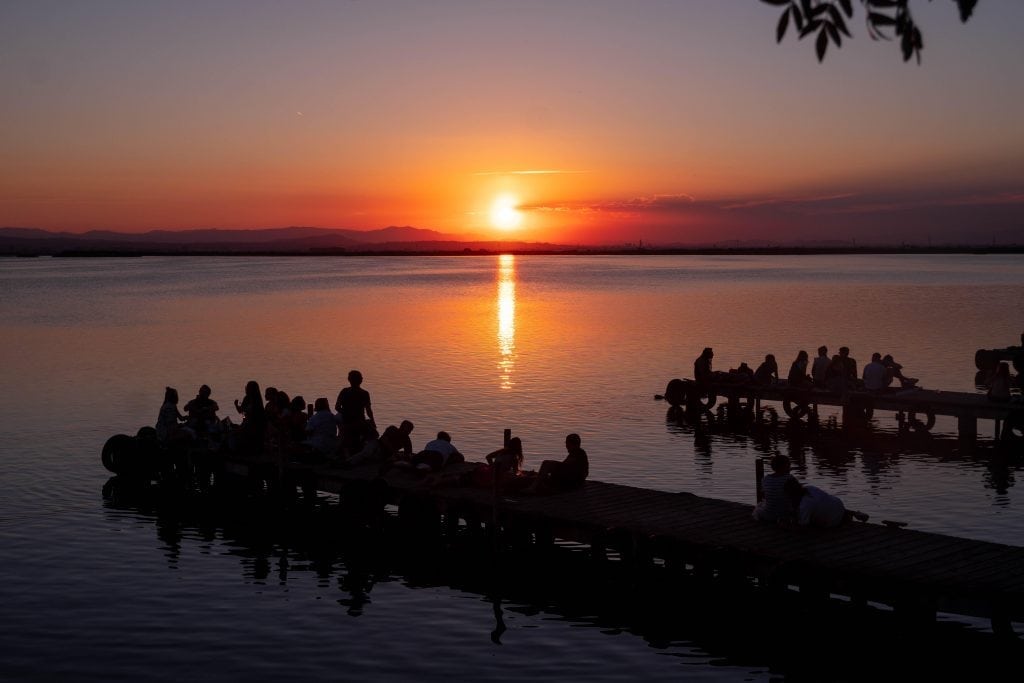Skift Take
For all its imperfections, Valencia still has its spirit and a sense of authenticity that other destinations have lost in some ways in the age of overtourism. As the city fights to maintain equilibrium, it has a unique opportunity to set an example via the proper management of tourism. Don't put doors in the field. Set up bike lanes instead.
Skift Senior Research Analyst Rebecca Stone is traveling the globe over the next year as part of Remote Year, a program that brings together working professionals to travel, live, and work remotely. She'll spend a month in 12 cities around the world that include Cape Town, Lisbon, Valencia, Sofia, Hanoi, Chiang Mai, Kyoto, Kuala Lumpur, Lima, Medellin, Bogotà, and Mexico City. And every month she'll take you along for part of the journey with a feature about her observations based on firsthand reporting and data about the changing travel industry. She'll do the jet lag. All you have to do is kick back and enjoy her compelling dispatches.
I had only been in Valencia for what felt like five minutes before I’d rented a bike and hit the road.
A relatively flat city with great bike lanes, Valencia, located on Spain’s eastern coast, made it easy for me to tear through the town, exploring all that the city has to offer. Within a couple days, I was speeding past tourists in ‘Ciutat Vella’ (the city center) to get to ‘El Jardín del Turia’ (Turia Park) where I’d ride all the way down to the ‘Ciutat de les Arts i les Ciències’ (the City of Arts and Sciences). I’d cruise the promenade along ‘Platja La Malvarrosa’ (Malvarrosa Beach) and ‘Playa del Cabanyal’ (Beach of Cabanyal), soaking in the sunshine and thinking of how the city looks like a lovely, little Los Angeles. I’d cycle downtown to the trendy and up-and-coming neighborhood of Ruzafa to enjoy a dinner of tapas with friends.
I couldn’t deny it. I felt immediately at home in a brand-new city.
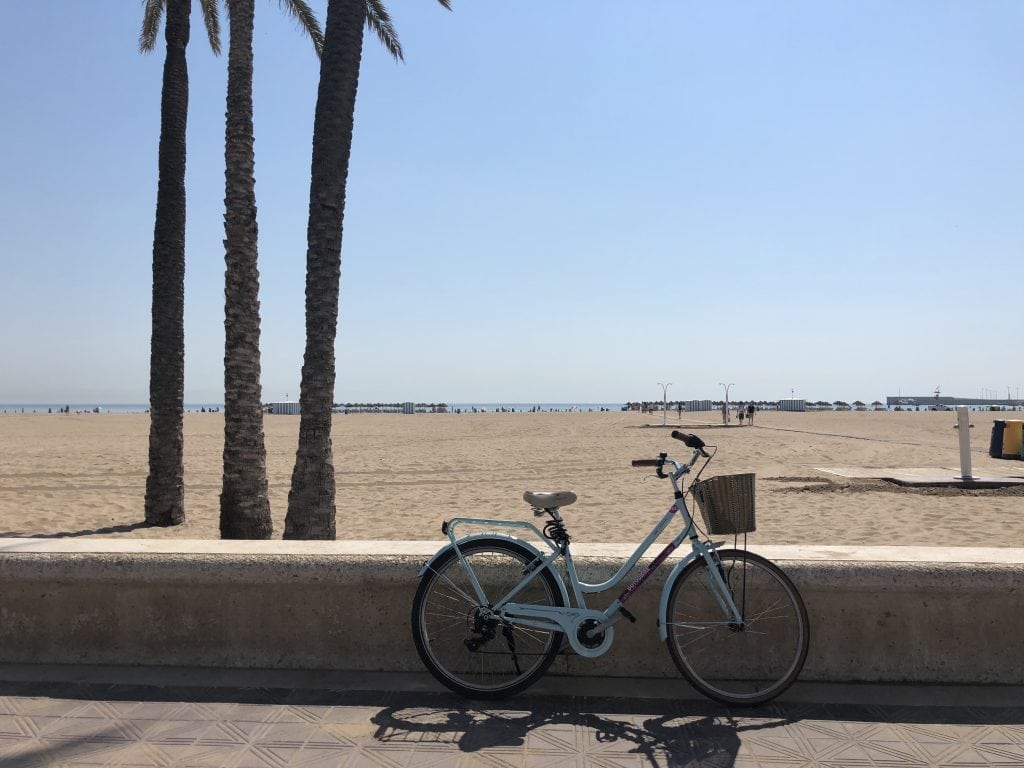
The author’s ride for the month at ‘Platja La Malvarrosa,’ (Malvarrosa Beach), just a 20 minute ride from the Ciutat Vella (city center).
Maybe it was thanks to my awesome high school Spanish teacher, without whom I would have been unable to navigate the city with basic Spanish phrases. Maybe it was the friendliness of the locals and, like mine, their love of good laughs and tapas to share. Maybe it was how the City of Arts and Sciences reminded me of the new Oculus building in New York City’s Financial District, where I used to live (The two complexes do share the same designer, Valencian architect Santiago Calatrava, after all.).
Or maybe it was the slight differences in Valencia’s backdrop as well as decisions the city is making, relative to some other European destinations, that set the stage for the city to still feel like home, to still maintain a sense of familiarity, hospitality, and authenticity.
What I would eventually come to learn via a month of bicycle rides throughout the city and numerous conversations with local individuals and organizations is that Valencia is in a delicate balance between old and new, with neighborhoods overrun with tourists and others with only locals; old, historical buildings and new investment; Spanish traditions and modern, international trends; considerable growth in tourism and huge economic problems. The city is currently fighting to maintain that equilibrium that so many destinations around the world have lost amidst ever-increasing numbers of tourists.
Putting Valencia on the Map
While in Valencia, I met private tour operator Sarah-Kate (‘Kate’) Redding, owner of Valencia Private Tours, who told me about how a few events that occurred a little over 10 years ago helped to essentially “put Valencia on the map.”
First was the inauguration of the City of Arts and Sciences (mentioned above). The arts and cultural complex, which features an IMAX Cinema, planetarium, science museum, opera house, Europe’s largest aquarium, and more, opened over a period of seven years, finishing in 2005 with the inauguration of the Palau de les Arts Reina Sofía (the opera house).
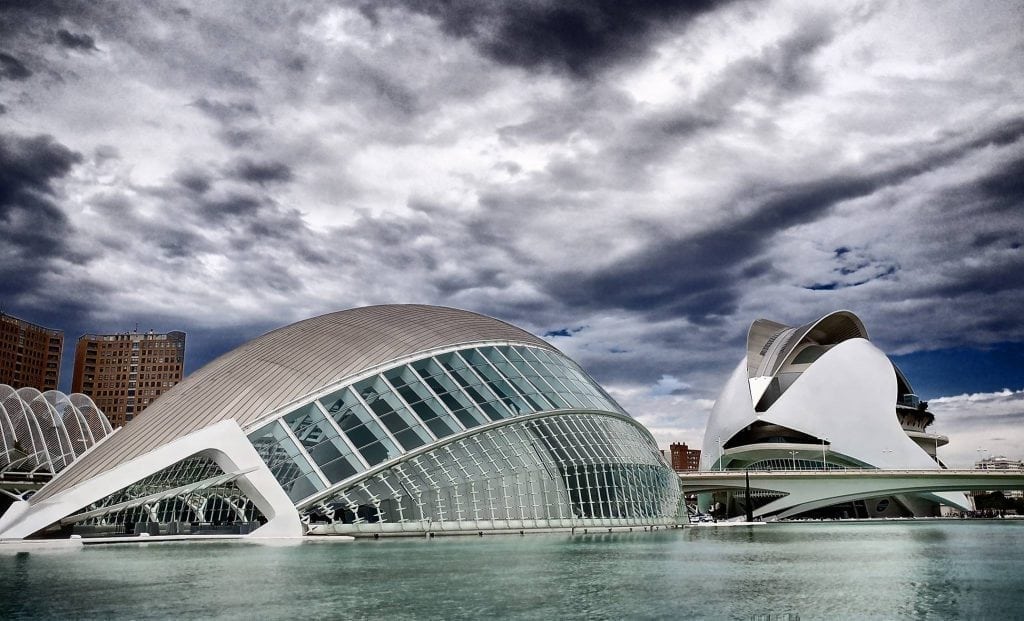
The massive City of Arts and Sciences complex helped put Valencia on the map. Photographer: David April
In 2007, Valencia hosted the 35th America’s Cup, which brought about the revitalization of the port area close to ‘Platja La Malvarrosa’ as well as a whole slew of wealthy visitors coming to check out Valencia, resulting in a net economic benefit of $4.6 billion (€3.9 billion) for the city.
Finally, the Valencia Street Circuit was established in 2007 for $730 million to host the Formula One European Grand Prix beginning in 2008, also bringing in a number of high-spending visitors.
In just 10 years, Valencia has become a popular destination for everyone, reaching almost five million overnight stays in 2017, representing a 3.2 percent compounded annual growth rate (‘CAGR’) over the past 10 years.
Source: Turismo Valencia
Growth continues to be strong, with international arrivals via air increasing 15.5 percent just last year to 2.4 million. According to data from AirDNA, Airbnb available listings increased from around 3,400 in May 2016 to 6,300 in May 2018 (a 37 percent 2-year CAGR). In fact, growth in available listings on Airbnb in Valencia has been outpacing that of Barcelona, albeit on a lower base.
Source: AirDNA
Source: AirDNA
While certain events helped to drive considerable tourism to the city, there, of course, have been some lasting negative ramifications.
In an effort to propel its economic growth into the global spotlight, Valencia (and Spain in general), put the cart before the horse in some ways. The City of Arts and Sciences came in more than four times over budget ($1.5 billion versus $350 million projected cost, or €1.3 billion versus €300 million projected cost). The Formula One racetrack was abandoned after only five races. The America’s Cup was hosted again in 2010, but had a dramatically reduced economic benefit and was referred to essentially as “a minor event.”
As I rode my bike along part of the abandoned race track as if it were a massive bicycle lane to the beach, passing by buildings constructed to support the America’s Cup regatta, with the City of Arts and Sciences complex looking massive even in the distance, I couldn’t help but feel the city may have overdone it just a bit.
These investments stand today as symbols of the problems that lavish spending can cause.
Spanish government debt still remains around 100 percent of GDP, significantly higher than pre-crisis levels. The unemployment rate in Valencia was 17.5 percent as of the third quarter of 2017, above Spain’s national average of 16.4 percent. The top 1 percent of the Spanish population owns one-quarter of the nation’s wealth, and Spain’s poverty rate is at about 22 percent. A recent survey indicated 68 percent of people in Spain think that “it is difficult or impossible for the average citizen to increase their savings, no matter how hard they work.”
For all of the problems that remain economically, the tourists aren’t going anywhere anytime soon either. Juan Carlos Sanjuán, CEO of Casual Hoteles, an innovative, affordable Spanish hotel chain with properties in six cities currently, described how when you now go to the city center of Valencia, “there are only tourists. There are no people who live in the city center. Why? Because it is so expensive.” He noted that monthly rental prices in the $940 range (around €800) are just too expensive for people who have a normal, monthly salary of 70 to 80 percent of that amount.
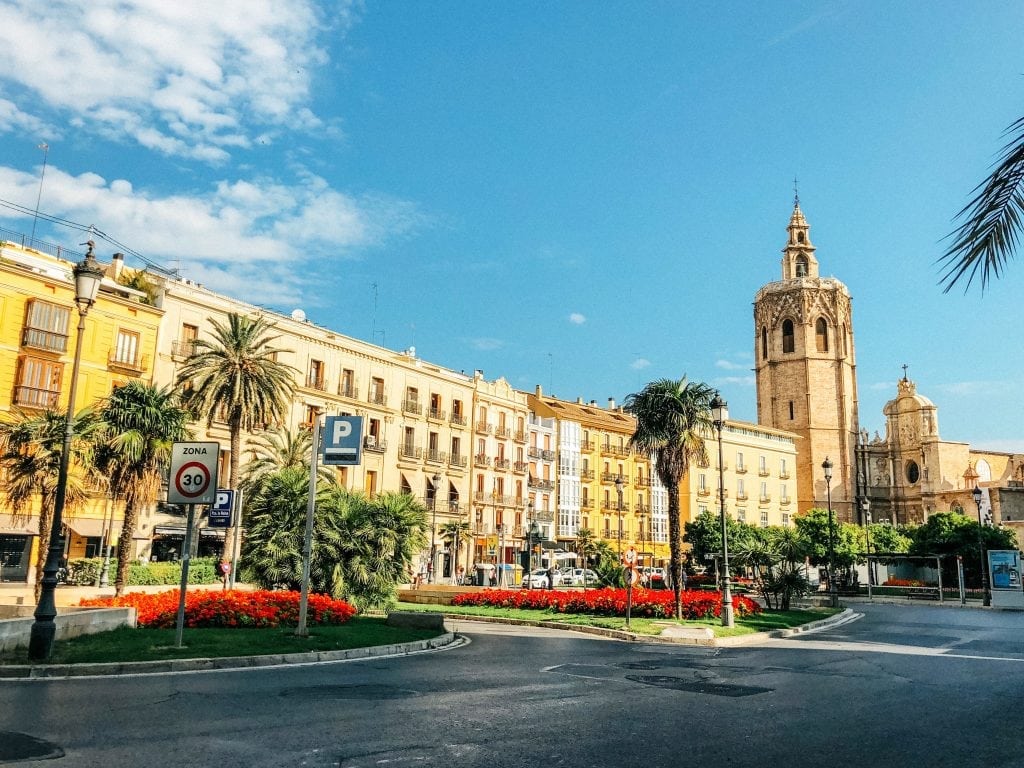
A view of the ‘La Seu de València,’ the Valencia Cathedral, in the center of the city, the ‘Ciutat Vella’ (city center), a generally crowded part of town.
Valencia Not Facing Problems of Overtourism Yet
Obviously, Valencia continues to face issues like that of the rest of Spain and hasn’t avoided all of the mistakes that its ‘big brother,’ Barcelona, has made.
Nevertheless, when I directly asked the team at ForwardKeys, a travel data analytics company that analyzes and projects global traveler movements, if Valencia faces issues of overtourism like other destinations such as Barcelona, Iceland, and Lisbon, Chief Marketing Officer Laurens Van Den Oever simply stated, “not yet.”
Data would suggest he’s right. The ratio of average monthly salary to average rent in Valencia remains higher than that of Barcelona and Spain as a whole. Hotel occupancies in Valencia still remain below that of Barcelona as well as the national average.
Source: Numbeo, Skift Research
Source: Turismo Valencia, Hotel Management, Christie & Co
Sanjuán echoed the sentiment that, as of now, things are okay. He compared Valencia to Barcelona, noting how Barcelona has been significantly more impacted by tourism, but he warned, “we are walking on the same way that Barcelona was.” Redding commented that “Valencia generally follows the trends of Barcelona 10 years later.”
Remaining Authentic in an Age of Overtourism
Because Valencia is not yet completely overrun, despite the significant influx of tourists, the city has a unique opportunity to be an example for other cities around the world. It can set an example via the proper management of tourism — setting appropriate regulations to benefit residents, proper marketing and promotion of the city, and investing in infrastructure that supports tourism.
As an example of building in regulations that benefit residents, Valencia is looking to limit holiday rentals to the ground and first floors of buildings as well as ban any additional rentals in the “Ciutat Vella” (city center).
Home rentals like Airbnb will be difficult to ban completely for the very reason that there is demand for them. Certain travelers look for the ability to have a kitchen, for instance, which generally can’t be found in a traditional hotel room. “Do not ban or put a black flag over the whole thing,” Laura Rodriguez, vice president, analytics, at ForwardKeys said. It’s not “black and white.”
Instead, home rentals need to be properly regulated and managed like that of any other industry — restaurants and bars, for instance — to limit illegal rentals while continuing to offer an alternative that travelers are seeking.
Destinations also need to start thinking about how to use marketing more strategically to have the intended impact that they want. At the end of the day, Valencia is a product that needs to be appropriately marketed.
Eva Monterde, content and communication executive for Turismo Valencia (Visit Valencia) explained how they are working to “divert tourists to different areas in the city,” such as Ruzafa, and away from areas such as the city center, beaches, and City of Arts and Sciences.
Sanjuán believes that many travelers think, “I want to see the shops where people buy the meat. I want to go to the central market and see the people buying the things they cook at home. I do not want to see tourists … buying an horchata.” He continued. “If I am a tourist, I go to Valencia to meet with the people … but now … [that means] going outside of the city center.”
Locals play a role in helping with that diversion of traffic. “Part of the solution of overcrowding is local communities, local guides, and local people helping out in explaining to go [to different parts of the city], because that’s really worth the effort,” Van Den Oever said.
There should be more press anyway for local tour guides and “local professionals — that they’re trustworthy, they’re friendly, they’re knowledgeable,” Redding commented. “Each city needs to take that into its own hands.”
Destination marketing organizations (DMOs) should also be using marketing strategies to adjust for seasonality, attract the right type of customers who have sufficient discretionary income, and help travelers learn about all the things the destination has to offer before the travelers book. DMOs need to “try to attract [travelers] in different seasons … [and] send out marketing campaigns at the moment when their markets are booking, not when they’re arriving,” Rodriguez stated. “The moment that I arrive is not the moment to change my plans … that is too late.”
When it comes to infrastructure, things need to be properly managed. Destinations still don’t have all of the necessary data to know how many four- and five-star hotels, how much airline capacity, how many cabs, and how many electrical sockets in the airport are necessary to support incoming travelers such that guests are offered a seamless experience. Some friends of mine had to walk two hours in the rain one night from the beaches back to their rental apartments in the city simply because there weren’t enough cabs to support the people who needed them.
Obviously, Valencia has more work to do, but its gorgeous Turia Park, constructed in what used to be the Turia River which flooded in 1957, and the endless bike lanes that have popped up in the last few years are some examples of public infrastructure that has been set up so that visitors and residents alike can enjoy the city.
“Valencia needs to believe that it’s a good city … that could grow more,” Sanjuán stated. “We are doing things well, but we need to do things better.”
As of now, Valencia “is in a good balance,” Monterde assessed. “We are still at a good point in the city.”
Valencia isn’t perfect, but it still has a spirit and authenticity that is refreshing compared to some other European destinations to which I have been. I had to quickly adapt to shops closing in the afternoon for a ‘siesta’ (a rest), the fact that paella is actually a dish served at lunch, their main meal of the day, and that dinner, which starts at around 9:30 P.M., will take at least three hours no matter how hard I try to get ‘la cuenta, por favor’ (the check, please).
But that was why I came to Valencia. In my never-ending quest to understand like a local, I have also learned that I should behave and live as if I were at home — be respectful to the people and their customs and traditions; talk to locals and get plugged into the community; go out of my way to go where locals go.
I took the train with some friends to Sagunto to explore the ruins of Sagunto Castle, where the only tourists were other Spaniards. My friends and I watched the sunset on L’Albufera, a freshwater lagoon, with wine and cheese and a bunch of other Valencians. I found buying fresh ingredients at the ‘Mercado Central’ (Central Market) and cooking dinner at home with my roommate was a better way to enjoy Valencia than sitting in a touristy café. I went to Radio City, a local spot with Flamenco dancing on Tuesday nights, and saw a play entirely in Spanish at ‘Teatro Olympia’ (Olympia Theatre). I rode my bike to work, to my friend’s apartment, to dinner, to run errands, and to explore every part of the city that I could.
“The beauty of Valencia is there are still so many untapped points of interest,” Van Den Oever noted.
At the end of the day, I was there because I wanted to be there. I was there, because I wanted to experience Valencia. I wanted to understand like a local, and live as if I were at home.
Don’t Put Doors in the Field
Juan Carlos Sanjuán told me about a Spanish idiomatic expression, “No poner puertas al campo.”
The literal translation is, “Don’t put doors in the field.” It might be most similar to our expression, “There’s no use in locking the stable door once the horse has bolted.”
There are home rentals everywhere, because travelers demand them, and homeowners want to supply them. There are travelers everywhere, because people want to travel. You cannot stop what’s already been done. You cannot set boundaries or limits on what has already occurred. You cannot contain the unavoidable.
But you can improve your product (in this case, your city). You can maintain your customs and traditions. You can promote unique areas outside of the city center. You can be innovative and creative. You can invest in infrastructure that maintains cultures and creates sustainable growth.
“The traveler is the customer. The traveler needs to travel,” Sanjuán explained. “They must come here and be at home. We must do all [so] that they feel at home.”
Don’t put doors in the field. Set up bike lanes instead.
I left Valencia for five days for a company retreat in Puerto Rico. As we were leaving, a coworker asked me, “Where do you head back to?” I responded, “Home. Ah, well. Valencia.”
The Daily Newsletter
Our daily coverage of the global travel industry. Written by editors and analysts from across Skift’s brands.
Have a confidential tip for Skift? Get in touch
Tags: barcelona, climate change, data and discovery, overtourism, skift on the road, spain, sustainability, valencia
Photo credit: The author's bicycle against a backdrop of colorful, Valencian street art. Rebecca Stone
